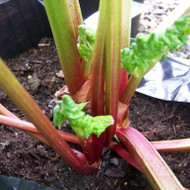During the dark winter months, it is almost inevitable that the mind starts to wander towards the coming Spring. The promise of slightly warmer weather, lengthening days and the first new shoots full of hope and expectation for the year ahead. in this guide we are going to look at one of the earliest crops for the fruit grower - Rhubarb. Before you start sending in letters, yes I know that technically it’s a vegetable, but it is generally considered a fruit and used as such, so we’ll treat it as part of the fruit garden for the purposes of this article.
After a brief recap of the essentials for growing, we will focus on flavour. We’ll look in depth at forcing techniques to get the sweetest stems, the best varieties to choose to suit your needs, and finally consider some slightly more unusual ways to use the crop in the kitchen.
Rhubarb is extremely hardy, and will tolerate a wide range of soils and conditions. It ideally prefers a rich soil which will not dry out in the summer months, so when planting rhubarb be sure to incorporate plenty of organic matter into the planting hole. Although it will tolerate shade, it does best in a sunny open site. Rhubarb actually needs a period of cold (below 5c) to stimulate growth in the Spring, hence the old practice of lifting crowns in November and leaving them exposed to frost over the winter months before replanting in late February. Don’t harvest any stems in the first spring after planting – leave the stems to develop so that all the energy goes into the plant establishing well and you will be rewarded with bumper crops in subsequent years.
As you are expecting the plant to produce a lot of growth every year, and taking energy out of the plant by removing stems, feeding is essential. A mulch of well-rotted manure in late winter is ideal as it is high in nitrogen and will help to conserve moisture. Be sure not to cover the crown of the plant, especially if you apply the mulch earlier in the winter, as this can trap excess moisture and cause the plant to rot. Otherwise apply a balance fertiliser late February such as Growmore or Blood, Fish and Bone.
Forcing.
The very sweetest stems are the very first ones the plant produces in Spring, especially when the plant has been ‘forced’. Traditionally this was done by moving crowns into large sheds, where they were kept in complete dark and the temperature controlled at about 14c. In these conditions, rhubarb grows so quickly you can hear the creaks as the new leaves emerge! You can achieve the same result by covering the crowns in late winter with a large bucket or upturned bin, around which can spread your mulch of manure (which helps warm the soil). Forced stems will be a beautiful shade of light pink, harvest when about 30-40cm tall.
Forcing rhubarb does take a lot out of the plant, so don’t force the same plant two years in a row. Either alternate between two plant, or give the plant a year off to recover. Whether you have forced the rhubarb or not, stop pulling stems by about July – they will have become noticeably tougher by then, and you need to let the plant rest and recover in order to ensure a good harvest the following year.
Varieties.
Timperley Early. As its name suggests, an early season variety and one that is superb for forcing. Pink-green stems with an excellent flavour, can crop as early as February.
Fenton's Special. A great all-rounder. If left to its own devices it crops around mid-season, but also does well when forced. Deep red stems with a sweet flavour.
Royal Albert. Also known as 'Prince Albert', this is very hardy, early to crop, and produces bright red stems.
Raspberry Red. Not the thickest stems, nor the heaviest cropper, but certainly one of the most naturally sweet varieties we offer.
Goliath. An excellent mid- to late season variety. Very heavy crops of thick, brick red stems - surprisingly sweet and the stems are not at all tough or stringy. Highly recommended.
Use.
Rhubarb is normally used poached or stewed as a filling for various pies, crumbles and cobblers. The classic method is to add a little water and some sugar and heat in a pan, but you can also roast rhubarb which means it keeps its shape and has a little bite, rather than collapsing into a complete mush. Cut into pieces, drench with castor sugar, and placed in a roasting tray covered with foil for about 15 minutes at gas mark 3/160C.
For extra flavour, honey, ginger and vanilla all work excellently with rhubarb. Vanilla sugar is excellent in many cakes and desserts, working perfectly with almost all soft fruit, so it is worth having some to hand in your cupboard. Put some castor sugar in an old clean jar, hide a vanilla pod in there, put the top on and leave for a couple of weeks. Add stem ginger (and some of the sugar syrup in comes with) to your crumble filling, for a little warmth and added kick to your rhubarb crumble.
Given that rhubarb is actually a vegetable, it shouldn’t really come as a surprise that it actually works well as an accompaniment to savoury dishes too, although it is rarely used that way. Try using roast rhubarb with grilled goats cheese, drizzled with a little honey - it’s a sublime starter. In much the same way as strawberries and mint are a match made in heaven, try adding a little lovage to your rhubarb. Best known for working well with peas, lovage is a very easy to grow herb which pairs beautifully with the acidity of rhubarb.
Alternatively, you can always make some rhubarb gin - as well as being delicious, the amazing pink colour makes it a fabulous gift. Cut 1kg of stalks into 3cm lengths. Put in a large jar with 400g of white castor sugar (not golden). Leave overnight to so the juices start to draw out of the rhubarb and then cover with 750ml of gin. Use the brightest pink/red forced stems for the very best colour. Ready to drink after 4 weeks, if you can wait that long!

